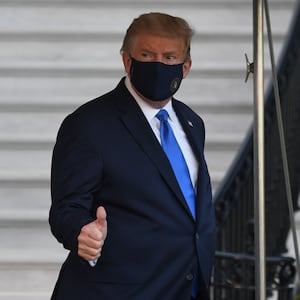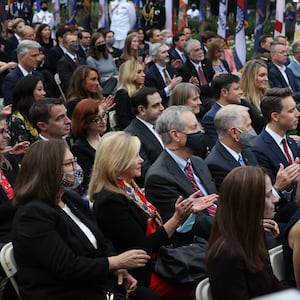The first briefing by President Trump’s doctors since the public was told he has the coronavirus raised serious questions about his medical condition and when he actually tested positive.
Standing outside Walter Reed National Military Medical Center, Dr. Sean Conley labored to paint a rosy picture of Trump’s health even as he repeatedly dodged questions about whether the president ever needed oxygen or how high his fever went.
And minutes after the briefing was over, a source familiar with the president’s situation—apparently White House Chief of Staff Mark Meadows, according to a reporter’s video—provided an anonymous and alarming statement to the White House pool reporters.
ADVERTISEMENT
“The president’s vitals over the last 24 hours were very concerning and the next 48 hours will be critical in terms of his care. We’re still not on a clear path to a full recovery,” the statement said.
That clashed dramatically with the remarks by Trump’s pulmonologist, Dr. Sean Dooley, who said the president told him, “I feel like I could walk out of here today.” In a Saturday afternoon tweet, Trump wrote that he was “feeling well!” and said in an evening video that he would “be back soon.”
Conley said Trump’s trip to Walter Reed was purely precautionary and a nod to his role as commander-in-chief. But the anonymous statement—and reports by The New York Times and the Associated Press that he was given supplemental oxygen at the White House on Friday—suggested the situation was more severe.
And Saturday night, after coming under withering criticism for his evasions, Conley issued an update that struck a somewhat different note: “While not yet out of the woods, the team remains cautiously optimistic.”
The mixed messaging and conflicting timeline marked a bizarre turn in the remarkable events that have been unfolding since 12:54 a.m. Friday morning—when Trump revealed that he and first lady Melania Trump had COVID-19.
Conley dropped a bombshell Saturday morning by saying it had been 72 hours since Trump was diagnosed with COVID-19, which would have made it Wednesday—some 36 hours before the public was informed, and also before the president traveled to several campaign events.
Conley also said the team “repeated testing” on Thursday afternoon after report of a close contact—which left open the possibility that Trump had a positive rapid antigen test earlier but was not quarantined until confirmation from the slower but more accurate PCR swab.
Further muddying the timeline, another of Trump’s doctors, Dr. Brian Garabaldi, said Trump received a “special antibody therapy directed at the coronavirus” 48 hours ago—which would be Thursday morning, more than a day before the White House put out a memo to say the president had been given the experimental infusion.
The doctors declined to answer follow-up questions about the timing but, an hour later, the White House claimed that Conley and Garibaldi had misspoken and actually meant to say it was Day 3 since a Thursday night diagnosis and Day 2 since the antibody therapy.
Another hour passed before Conley put out a written statement saying he “incorrectly” used the phrases 72 hours and 48 hours. “The President was first diagnosed with COVID-19 on the evening of Thursday, October 1st and had received Regeneron’s antibody cocktail on Friday, October 2nd,” the statement said.

White House physician Dr. Sean Conley provides an update.
ReutersBut Conley refused to say at the briefing, and did not clarify in the statement, whether Trump had tested positive before “being diagnosed.”
At the briefing, Conley clearly chose his words carefully to present a picture of stability and refused to provide some details about Trump’s illness.
“This morning, the president is doing very well,” Conley said, adding that the medical team is pleased with his progress.
But his comments raised far more questions than they answered. For instance, asked whether Trump had lung damage, Conley said he had undergone ultrasounds. That did not answer the lung question and created another: Were the ultrasounds for his lung or for another body part, like the heart?
He said Trump did not need supplemental oxygen Thursday, Saturday, or “when we were all here” on Friday—but he danced around the question of whether the president had been on oxygen at any point in between. The Times and AP reports of oxygen being given on Friday at the White House suggest Conley did want to disclose that and framed his answer so he did not have to but was not blatantly lying.
Conley also said Trump’s fever is gone, though he would not say how high his temperature had been. And he claimed his cardiac, liver and kidney function was normal.
The president’s oxygen-saturation rate on Saturday hovered between 96 and 98 percent, which is not in the danger zone, but his doctors did not say if it had ever been lower. Hours later, Meadows told Fox News that on Friday “his blood oxygen level had dropped rapidly.”
Trump also received a dose of the experimental anti-viral remdesivir at Walter Reed on Friday—and a second one on Saturday. Conley said it had not been decided if he would get the full, five-day course or how long he might be hospitalized.
He did note that the the peak period for the inflammation phase that can make coronavirus so life-threatening is seven to 10 days after onset, and Trump has not passed through that.
Meanwhile, Melania, 50, still has only mild symptoms and did not go to the hospital. Her spokesperson, Stephanie Grisham, told reporters Saturday morning that she is “doing well” and “continues to rest.” Her symptoms have not worsened, Grisham said, and she “remains in touch with her husband.”
The couple are two of eight people who contracted the coronavirus after attending a Rose Garden ceremony last Saturday, but other D.C. Republicans and Trumpworld figures who were not at that event—like Trump adviser Hope Hicks—have also tested positive in the last three days.
Trump announced his diagnosis shortly after reporters broke the news that Hicks, who traveled with Trump several times in prior days, had tested positive. The White House said it learned of Hicks’ diagnosis on Thursday afternoon, “right as Marine One was taking off” with Trump for a fundraiser at his golf club in New Jersey. The fundraiser went ahead regardless.
In the aftermath of Trump’s diagnosis, footage has circulated of him interacting with other prominent officials and members of the GOP in the last several days. In the past 24 hours, Sens. Mike Lee (R-UT), Thom Tillis (R-NC) and Ron Johnson (R-WI) have announced positive test results.
On Friday morning, the administration had been adamant that the president would continue to work as usual. But he missed the one item on his public schedule for Friday, a noon phone call with state leaders about COVID-19.
By Friday afternoon, the administration said that the commander-in-chief would be airlifted to Walter Reed. “Going well, I think!” Trump tweeted Hours after his hospital admission. “Thank you to all. LOVE!!!”
At the time, Trump was experiencing a low-grade fever, with chills, nasal congestion, and a cough.









